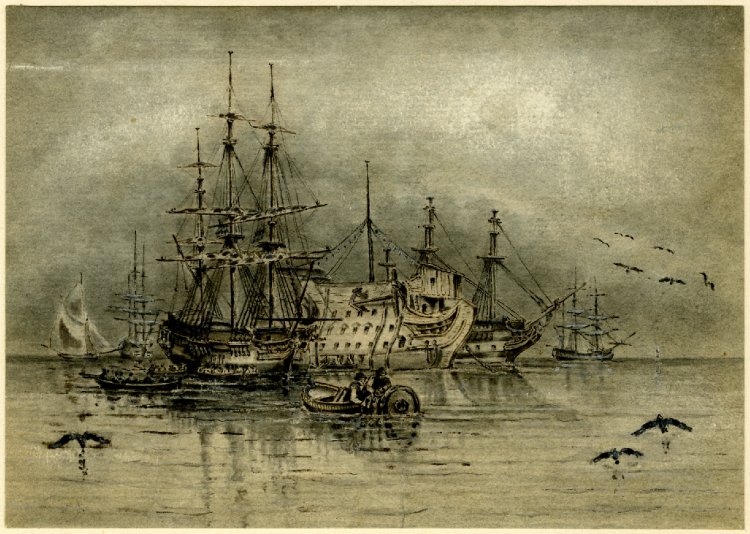Boys Recruited into the Marine Society, 1770-75, 1780-83, 1792-93, 1800-04 (MAR)
 Thomas Mitchell. Sheerness. c.1763-1789. British Museum, Binyon 14(a) © Trustees of the British Museum.
Thomas Mitchell. Sheerness. c.1763-1789. British Museum, Binyon 14(a) © Trustees of the British Museum.
Introduction
The 1,385 individual records of boys recruited to the Marine Society included in London Lives were created as a part of a comprehensive longitudinal study of the heights of adolescents and adults in Britain and North America, as a measure of changing nutrition. Completed in 1986, and led by Professor Roderick Floud, the full dataset and project description is available through the UK Data Archive:
The dataset posted on the London Lives website encompasses samples from the Marine Society Registers covering the periods 1770-75, 1780-83, 1792-93, and 1800-04. These are available for keyword and name searches only. If you wish to undertake a statistical analysis of this material you can access the full dataset in a range of formats through the UK Data Archive. Copyright in this material remains with the original investigators, and the data is reproduced here by license, for non-commercial use only. Please also note this database includes only a sample of the fifteen thousand or so boys recruited by the Society in the eighteenth century. If you are undertaking genealogical research you may need to consult the original registers.
An associational charity of a sort that typified mid eighteenth-century philanthropy, the Marine Society was initially established in 1756, closed in 1763, and then re-opened in 1769. By 1940 the society had fitted out and sent to sea some 110,000 boys. Initially, some parishes used the society to off-load vagrant children. But in its second incarnation, by the 1770s when the information included here was recorded, the Society's recruits were drawn from the children of the settled poor and artisans. In addition to an explicit willingness to be sent, boys had to be at least thirteen years old, and 4’ 3’’ tall.
The Registers
The original registers are held at the National Maritime Museum, and from 1770 onwards record comprehensive details about the recruits, including their state of health, their height, age, literacy, previous occupation and domestic circumstances. The original registers also include details about the ship and ship's officer to which the boys were assigned and the port at which the ship was stationed. This latter information was not included in the Marine Society Database.
The Database
The database is divided into eighteen separate fields. Where fields are blank in the original they have been suppressed in the version displayed here. Where information is available for each possible field the record will include:
- Unique Project ID: Unique identification number.
- Unique Individual ID: Unique ID associated with a single individual.
- Age: Normally given as a whole number.
- Year of Birth
- Height in Feet
- Height in Inches
- Reading Literacy, Yes=1, No=0
- Writing Literacy, Yes=1, No=0
- Has had the Smallpox, Yes=1, No=0
- Date: Year of entry in the Register.
- Surname
- Forename
- Nearest Named Relative: A standardised relationship label, ie. Uncle.
- Relative's Occupation: A standardised occupation label.
- Boy's Occupation: A standardised occupation label.
- Date of embarkation: Date accepted as a part of a ship's company, given in a shortened form.
- Parish: A standardised parish name.
- Town (outside London): A standardised town name.
A typical entry (with blank fields suppressed) looks like:
- Unique Project ID: 721
- Unique Individual ID: 2585
- Age: 13
- Year of Birth: 1768
- Height in Feet: 4
- Height in Inches: 3
- Reading Literacy, Yes=1, No=0: 1
- Writing Literacy, Yes=1, No=0: 0
- Smallpox, Yes=1, No=0: 1
- Date: 1781
- Surname: BENNETT
- Forename: NICHOLAS
- Nearest Named Relative: UNCLE
- Relative's Occupation: WEAVER
- Boy's Occupation: ERRAND BOY
- Date of Embarkation: 3SEP81
- Parish: BETHNALL GREEN
The data included under the two Occupation fields and the Parish and Town fields have been standardised. For a description of the methodology employed, see the original project Code Book.
Using this Dataset in London Lives
The names of the boys in these registers are unlikely to appear in the Old Bailey Proceedings (OBP) or Sessions Papers (PS), or in the records of St Thomas's Hospital. There is a rather greater chance, although still slim, that they will appear in parish records and those of Bridewell. But, given the social background of the children involved, links are more likely with the Westminster Historical Database (WHD); while their future occupation as seamen means that their wills could well be listed among those proved at Canterbury (PCC).
Original Sources
The original registers from which this database is drawn are held at the National Maritime Museum, and form a part of the Marine Society Archive. They are formally called the Registers of Boys Entered as Servants in the King's Ships, and the full series encompasses the period 1770-1873. They are catalogued as MSY/O/1-15.
Introductory Reading
- Floud, Roderick, Wachter, Kenneth, and Gregory, Annabel. Height, Health and History: Nutritional Status in the United Kingdom, 1750-1980. Cambridge, 1990.
- Payne, Dianne. Rhetoric, Reality and the Marine Society. London Journal, 30:2 (2005), pp. 66-84.
- Pietsch, Roland. Urchins for the Sea: The Story of the Marine Society in the Seven Years War. Journal for Maritime Research. December 2000.
- Taylor, James Steven . Jonas Hanway, Founder of the Marine Society: Charity and Policy in Eighteenth-Century Britain. London and Berkeley (CA), 1985.
Online Resources
- Floud, R., Long-Term Changes in Nutrition, Welfare and Productivity in Britain
- National Maritime Museum, Marine Society
- The Marine Society
For further reading on this subject see the London Lives Bibliography.